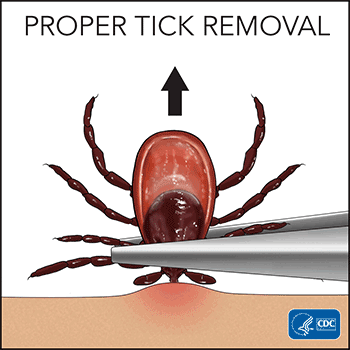
From May through July, people will get more tick bites and tick-borne diseases than any other time of year in the United States. Outdoor areas with woods, bushes, high grass, or leaf litter are likely to have more ticks. Avoiding these areas are the best prevention, but repellents that contain 20 percent or more DEET, picaridin, or IR3535 on exposed skin can last several hours. Plus wearing light colored clothing is also important to protect yourself.
Find out more information on ticks from the CDC
What diseases do ticks transmit?
In Ohio, there are three (3) diseases that that are of concern: Lyme Disease, Rocky Mountain Spotted Fever and Ehrlichiosis. The Centers for Disease Control has very good information about ticks and the diseases they can carry. If you suspect you might have a tick transmitted disease, please seek immediate medical attention.
How to remove a tick?
If a tick is attached to you find out to remove it from your body
Can ticks be tested for disease?
No, the Ohio Department of Health no longer tests ticks for the presence of tick borne diseases.
Can ticks be brought in for identification?
Yes, Knox Public Health's Environmental Health staff will identify the species of tick and explain what diseases are associated with the identified tick. In some cases, the tick may be submitted directly to the Ohio Department of Health (ODH) for further identification. In order to have a tick identified, please take the following steps:
- Ticks attached to humans and pets may be dropped off at our department during normal business hours.
- Ticks must be kept and transported in a small air-tight container, such as a pill bottle or baby food jar;
- Place into the container with the tick a ½ inch strip of paper that has been moistened with one (1) drop of water (the paper does not have to be saturated, just damp);
- The person dropping off the tick will be required to complete the Ohio Department of Health (ODH) Tick and Insect Identification Form. This form will be available from Environmental Health staff;
- An Environmental Health staff member will contact you by phone and/or email with the tick identification when we receive it from ODH.
- If you have any medical concerns concerning tick-borne diseases or symptoms, please discuss the situation with a medical physician.
The Ohio State University is conducting a research project to collect ticks from all over the state of Ohio for identification and pathogen testing. If you would like to submit a tick for this research click here. (Please note, OSU submissions are for research purposes only. Unlike diagnostic fee-based laboratories, OSU is not able to provide results to participants.)
